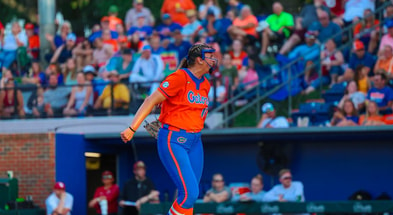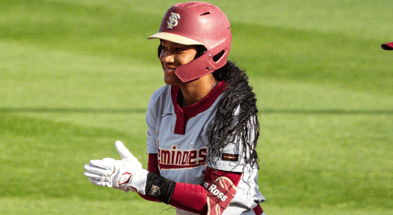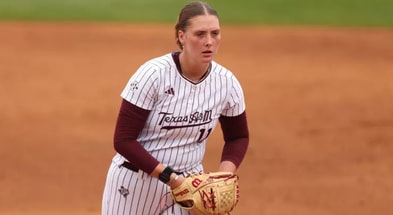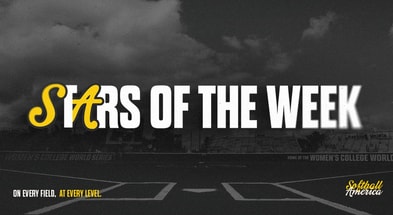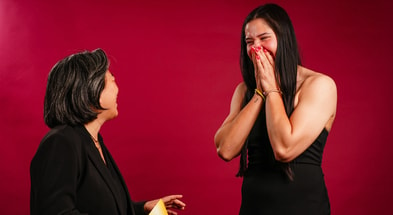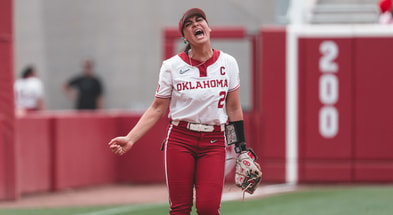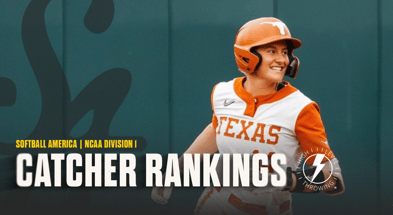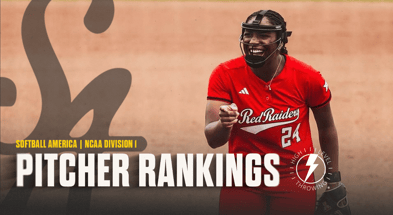Mississippi State’s Self-Made Sierra Sacco Remakes Herself into One of the NCAA’s Best

In an age when it is harder than ever to fly under the recruiting radar, one of the best hitters in the SEC initially committed to Pearl River Community College in Poplarville, Mississippi. It was just about the only school that seemed to know who she was.
When Louisiana Tech caught on late in the process and offered the speedy kid from near New Orleans a place, she made herself into one of the most prolific slappers in Division I.
Movie scripts have been written about less improbable ascents.
But Sierra Sacco was just getting started.
As good as she was at Tech, she didn’t want to wait for occasional midweek opportunities to avoid run-rules against SEC teams. She wanted to play against the best every weekend. To some, the transfer portal is a shortcut. It’s the easy way out. Nothing about the gnawing doubt felt easy to her as she submitted her name and wondered if she would find any takers.
Mississippi State head coach Samantha Ricketts thought the rising junior could add some speed from the left side, shore up the short game and plug a hole in the outfield defense. Indeed, Sacco aced the transition to slapping in the nation’s toughest conference, hitting .347 with a .492 on-base percentage and 19 stolen bases in 2024—41 of her 52 hits singles.
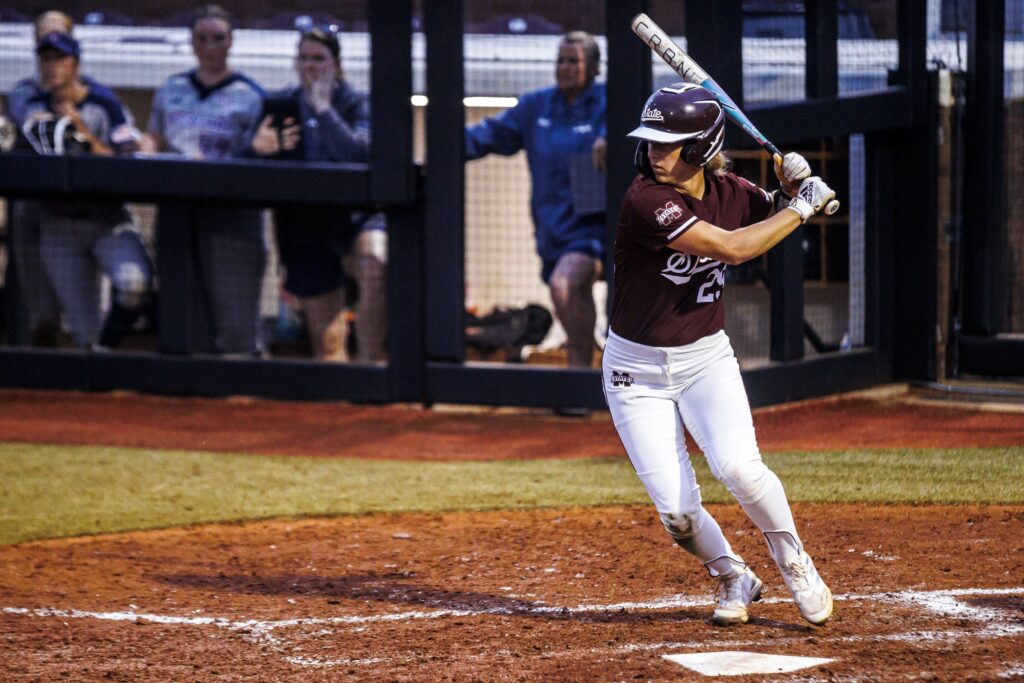
Surely, that’s when the screen fades to black and credits roll, with the kid who came from nowhere standing on first base.
Not quite. Not when a slugger lurked inside the slapper. Spending the summer in Starkville, where there are decidedly few distractions without the more than 20,000 students who swell the population during the rest of the year, Sacco went to work. She honed the skills to swing away and emerged as one of the most complete hitters in college softball.
Entering the weekend, she’s hitting .486 with an .824 slugging percentage. She has 10 home runs and 14 doubles, more doubles and home runs than she had among 191 hits in her first three seasons. She ranks fourth among SEC hitters in wOBA, trailing only Arkansas’ Bri Ellis, Texas’ Reese Atwood and Tennessee’s Taylor Pannell.
The slapper no one wanted has come the slugger no one wants to face.
“She’s always kind of described herself as self-made,” Ricketts said, “With the way that she came up through school and travel ball and didn’t have a lot of opportunities—and then the same thing going in the portal. She’s just always bet on herself and had to push herself. She didn’t have a whole lot of support around her to do that for her. We tried to really be that support system for her and just let her flourish with a bunch of people in her corner that believed just as much as she did in how good she could be and what she could do in her time with us.”
Finding Mississippi State
In a conversation earlier this season, lamenting how quickly her two years in Starkville were coming to an end, Sacco almost plaintively asked Ricketts why she couldn’t have just recruited her out of high school. Ricketts could only wistfully assent—but she wasn’t sure she had even heard of Sacco’s travel team, let alone one of its players from Marrero, La.
By the time Sacco entered the portal, on the other hand, Ricketts had more of a scouting report. She got a serendipitous assist when football staffer Kyle Schexnayder, a New Orleans native, recommended Sacco. And Ricketts also had firsthand knowledge. Not only had Sacco reached base via a hit and a walk and scored a run against Mississippi State early in the 2023 season, she cut down a runner at the plate with her throw from center.
But it wasn’t until Sacco visited campus over the summer in 2023 that Ricketts started to think there was more there than speed, singles and a good glove.
“Getting to see her up close, we just immediately noticed how strong she was,” Ricketts said. “You could tell that she worked out hard and that she took it serious and that she wasn’t just a prototypical slapper, small in stature, small and fast.
“She was an athlete and she was built like one.”
It’s not as if Sacco had been carefully molded into a slapper. There wasn’t a lot of careful molding of any kind going on with her swing. She didn’t do expensive hitting lessons. She didn’t try out for well-known teams. She just, well, played. Somewhere around middle school, coaches told her to try slapping. With her speed against inconsistent defenses, she just needed to keep the ball fair to end up on first base. So she kept doing it, all the way to a .441 average as a freshman at Louisiana Tech—eighth-best in Division I and the best by any freshman that year.
Transferring a year later wasn’t about a specific desire to swing away more. But when she got to Mississippi State and started registering exit velocities in the mid-70s with a smooth natural swing, Ricketts and the rest of the coaches, including hitting guru Zac Shaw, jokingly asked her what the heck she was doing wasting her time slapping. Well, mostly jokingly.
Sacco sometimes took hacks. She just wasn’t comfortable enough to do it regularly in games. Ricketts assured her that Mississippi State had the tools to help with that—a lot of tools.
The Science of Hitting
Not exactly ancient herself, despite her players teasing her otherwise, Ricketts certainly benefited from improved resources during her All-American career at Oklahoma in the 2000s. The tools available to her were a far cry from those available to previous Oklahoma teams early in Patty Gasso’s tenure, which played in a public park. But even 20 years ago, doing the same weight training routines as the football team, Ricketts and her teammates weren’t exposed to anything like the specialized sports science resources that helped Sacco make the leap to world-class run producer.
In a different era, explaining Sacco’s growth might begin and end in the batting cages. This story talks a lot about working hard and many thousands of swings. And indeed it will—those things still matter, just as they did in the now oft-repeated stories of Odicci Alexander making herself into a superstar through YouTube pitching lessons and a wall in the backyard.
Top 10
- 1New
Iowa State gambling
Staff members punished
- 2
Tennessee AD
Reacts to Texas roster cost
- 3Hot
2026 NFL Mock Draft
QBs dominate without Arch Manning
- 4
Second-guessing Sark?
Ewers-Manning decision in spotlight
- 5Trending
Fiery crash video
Alijah Arenas football surfaces
Get the On3 Top 10 to your inbox every morning
By clicking "Subscribe to Newsletter", I agree to On3's Privacy Notice, Terms, and use of my personal information described therein.
But equally important in stories today, if less nostalgic, are tools like counter movement jump monitoring, where coaches and sports science staff can track and understand lower-body explosiveness and neuromuscular fatigue. While praising Sacco’s old-school instincts, Ricketts can in almost the same breath discuss jump height, body mass and absolute and relative power—scrolling her laptop to try and find the off-the-chart numbers that underscore both Sacco’s natural athleticism and targeted improvement through strength training.
And unlike days gone by when basketball star Jackie Stiles’ famed 10,000 daily shots regimen surely also contributed to her body breaking down too soon, sports science helped Sacco work smarter and stay on the field. She came to Starkville with a lingering hip issue, the sort of thing that could be—and initially was—aggravated by the force required to take a big swing.
On the field, while Sacco’s production in her first season with the Bulldogs looked similar to what she did at Louisiana Tech, she was building toward a new approach. While Sacco’s patience at the plate is an asset, especially in the leadoff role, Mississippi State coaches worked with her on count management. For example, she rarely, if ever, swung on a 2-0 count last year, which perhaps helped her draw a few more walks but also denied her what is statistically one of the best pitches to try and drive. Similarly, she took the first pitch of an at-bat more than 70 percent of the time at Louisiana Tech, a figure now below 60 percent at Mississippi State.
With the transition to the SEC comfortably behind her after a strong debut season, she then spent last summer in Starkville with an offseason plan to help her take the next step.

“Knowing that I had more in store than just being the slapper,” Sacco said, “I think we really just dialed in on my stand-in swing and my stand-in approach and just working on that and getting down to the nitty-gritty of how you load, how you’re supposed to move, what sequence you’re supposed to do it in. I never knew that as a hitter. I just threw my hands at the ball pretty much and hoped for the best. So just actually learning what it is to hit was kind of our approach.”
This was before she hit two home runs in the same game against Louisiana Tech in February, two more than she hit in her entire time in Ruston. It was before she hit three doubles in a game against Penn State or homered in back-to-back games at Oklahoma. Sweating through the Starkville summer, she hadn’t seen any reward yet. And not unlike when she entered the portal, she didn’t have any guarantees it was going to work out.
“It was definitely stressful at times,” Sacco said. “You’ll be in the cages one day and have an awesome day, and then the next day everything is off and you’re back to square one. That was definitely frustrating. But just knowing that I am a good athlete and I have a good swing and it’s all going to come together. Just trusting the process was really key for me because I want to be perfect. As soon as I do something, I want to be the best at it. So it was keeping that mindset but also trusting the process.”
She could have left well enough alone. Who would have blamed her? Who would have even noticed had she merely played out her final season as an All-SEC-caliber slapper?
Well, she would have. That’s the point. Even when no one but a local community college knew her name, that was the point.
“I like the fact that hitting is hard,” Sacco said. “I like that fact that being a good hitter is rare and not many people can do that. So I think I like just the challenge of it all and just competing against myself every day. It’s not that I’m competing against another person, it’s literally you versus yourself. I think that’s the part that I enjoy the most.”
It’s fun tormenting defenses by beating out singles. But when you get right down to it, nothing beats a slow jog around the bases.
“I wish I would have learned all this about my body and that I could actually hit the ball a lot earlier,” Sacco said. “Because I think I would’ve done a lot more besides what I have done.
“This is a lot more fun than just slapping.”
More from Softball America:
College Softball Conference Power Rankings: SEC | ACC | Big 12 | Big Ten
Latest Softball America Bracketology
Bubble Watch: Week 12
